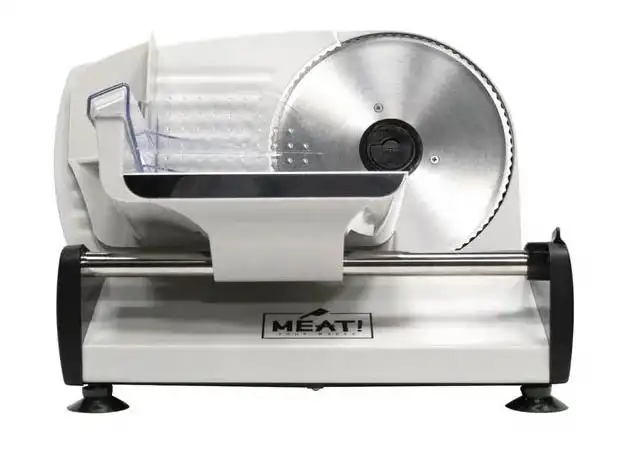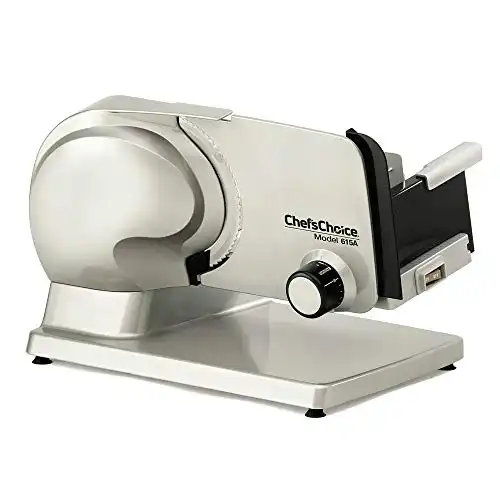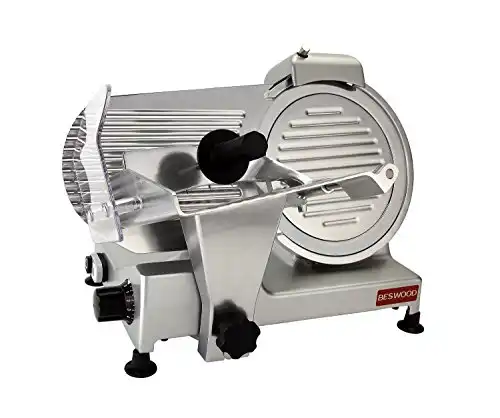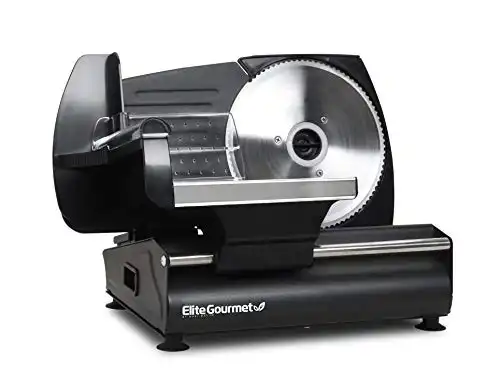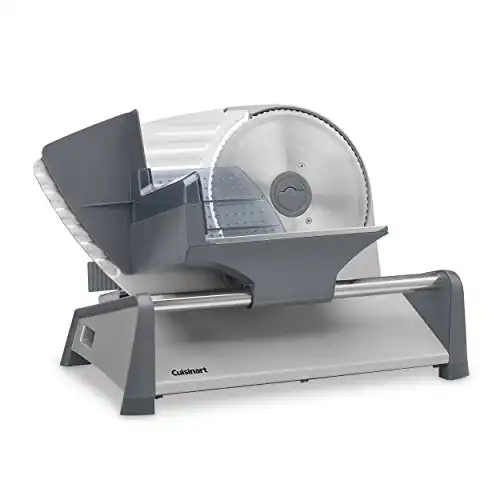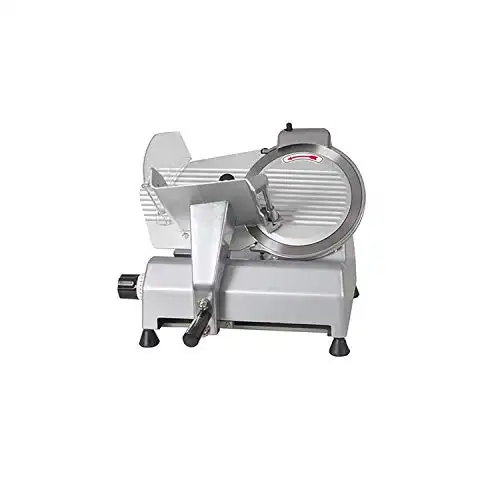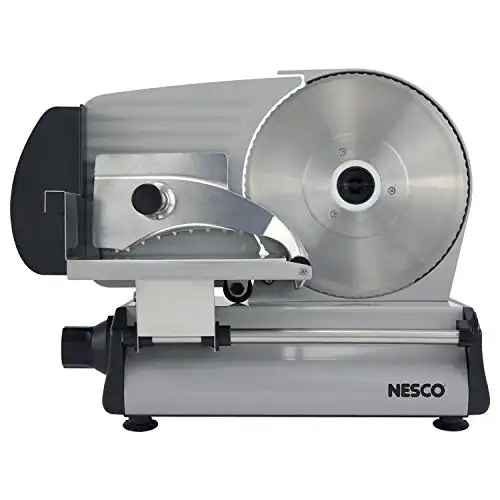The 7 Best Meat Slicers for Home Use in 2024

Meat slicers aren’t just a tool for butcher shops and delicatessens.
If you need to process a lot of meat (or vegetables or cheese) then hand slicing can be tiresome.
Plus, it’s hard to keep your slices consistent.
A good meat slicer should be able to help you in both these areas. They come in both manual and electric varieties and let you slice meat to the thickness you desire.
The best option for most people is the 7.5″ Electric Meat Slicer from Meat! Your Maker. It’s easy to use with a super sharp cutting blade at an affordable price.
We’ll run through why we like it in more detail, plus a bunch of other great options at various price points.
- Sharp durable blade
- Easy to adjust cutting thickness
- Easy clean-up
- Some plastic parts
- Food gets stuck in nooks
Our top picks for the best meat slicer in 2024
1. Best Overall – MEAT! Your Maker 7.5” Electric Meat Slicer

The MEAT! Your Maker 7.5” slicer is good for light slicing needs.
I think it’s the best meat slicer for most people, assuming you aren’t running a sandwich shop or deli out of the back of your house.
It will handle most cuts, although if you want to slice large slabs of bacon you might want to upgrade to the 10″ version. It’s quite a big price increase, but you get a product that’s designed for the high-end enthusiast.
The 7.5″ model is definitely the value option though.
The slicer is easy to use and store, with convenient disassembly for quick clean-up. Adjustable thickness and an extended tray allow for a moderate volume of meat to be cut at one time.
The suction cup feet keep it firmly rooted in place, so you can be confident in slicing dense food like cheese.
The aluminum housing feels durable, but some parts are still plastic making me wonder how long they’ll last under heavy use, but MEAT! has a limited lifetime warranty that should ease your mind.
What we like:
- Sharp Blade – The 7.5” stainless steel blade is durable and sharp out of the box. It is easy to remove from the base for quick cleaning.
- Easy to adjust thickness – The thickness knob on the back of the slicer is easy to adjust from 0 – 15mm.
- Convenient Disassembly – The food carriage, slicing guard, meat holder, and blade all remove quickly and easily so you can take them to the sink for clean up.
- Safety on/off switch – The power switch comes with a safety mechanism to ensure no accidental power-ups happen.
What we don’t like:
- Plastic parts – Though the base and housing are aluminum, there are still some plastic parts, including the gears. They feel a bit rigid, so jury is out on long-term heavy-duty usage.
- Only serrated blade option – The blade is sharp, but is serrated which can tear and shred meat at thinner sizes. Plus, they are more difficult to sharpen when necessary.
- Food gets stuck in nooks and crannies – Though the removable parts are easy to clean, small pieces of food get stuck in the many crevices of the housing, making cleaning the base tedious when having to pick it all out. Better sanitary than sick though.
If you’re looking for a slicer that can handle all your household slicing tasks the Meat! 7.5″ slicer is a great option at a reasonable price.
2. Runner Up – Chef’s Choice 615A Electric Meat Slicer
The 615A from Chef’s Choice is a popular electric meat slicer for home use, although it could probably handle some light commercial use. It’s also going to cost a little more than the Meat! slicer.
This slicer is an excellent “light” heavy-duty cutter. It boasts excellent design features and enough power and control to be useful for both casual and serious chefs alike.
What we like:
- Easy-to-clean, removable parts – The 7-inch blade used by this slicer is easy to clean since you can lift it away from the main machine. Like the blade, the food carriage, deflector and thickness guide plate can also be removed for cleaning.
- Stainless steel material – This coating both looks fashionable and keeps the meat slicer durable over time. It’ll be less susceptible to rust damage.
- Powerful motor – The high torque motor here is great for sawing through even tougher meats that resist initial cutting.
What we don’t like:
- Only comes with serrated blade initially – This blade is fine for casual use. But slicing certain meat types is more difficult with a serrated edge. You have to buy a separate blade if you want a non-serrated edge. In addition, serrated blades are harder to sharpen.
- Struggles to achieve thinnest cuts – If you want to slice ribbon thin you might be better off looking at a more expensive option.
3. Best Commercial Grade – BESWOOD 10” Premium Chromium-Plated Electric Meat Slicer
This Beswood 10″ slicer can compete with electric commercial meat slicers that cost thousands.
It’s a hefty unit at 35lbs, especially compared to some of the other meat slicers we’ve looked at. Everything is made from stainless steel and aluminum so you know it’s going to last.
You can get razor-thin slices easily, and it will even handle semi-frozen meat.
What we like:
- Chromium-plated/carbon steel material – The blade is made of carbon steel, then coated with chromium. Both of these materials protect against corrosive damage and improve the tool’s lifespan. This also lowers the amount you need to sharpen the blade.
- Low noise – The V-shaped feeding belt for the motor helps this meat slicer remain quiet and vibrate softly.
- Large 10” blade – This size of blade is ideal for those who are going to cut big chunks of meat into narrow slices. You can feed a ton of food product into this machine and get it sliced up in no time at all.
What we don’t like:
- Hard to remove blade – While this blade doesn’t need to be sharpened often, it does need to be cleaned. Removing it for cleaning requires that you unscrew it from the slicer as a whole. It’s tedious work to perform after each use.
4. Best Budget – Elite Platinum EMT-625B Ultimate Meat Slicer
If you don’t want to invest as much money on meat slicer, then the Elite Platinum is an affordable slicer. This is the best value option out of all the meat slicers we have reviewed.
It’s not the most heavy-duty option, but it will handle salami, ham, or turkey without any trouble.
What we like:
- Die-Cast aluminum material – This material can prevent rust damage. It will also improve durability, just like stainless steel. But it costs a lot less. The result is a more affordable meat slicer.
- Easy to adjust thickness – The thickness settings of this meat slicer can be tuned with a flick of your wrist. There’s also a good difference between the thinnest or thickest settings.
- Safety guide – This part once you keep track of food as you guided towards the cutting blade without having to risk your fingers.
What we don’t like:
- Slow and loud – This slicer’s motor makes quite a racket in any kitchen. While it can cut thick or thin slices, either type will require a little extra time than higher-priced models.
5. Cuisinart FS-75 Kitchen Pro Food Slicer
This meat slicer has components of higher or middling quality depending on the part.
What we like:
- Most parts removable – The removability of most of the major components of the slicer means that cleanup is a breeze.
- Good thickness range – You can choose between 1/32 of an inch to ½ of an inch. That’s lots of wiggle room to identify the best-sized slice of meat for your needs.
What we don’t like:
- Plastic meat holder is flimsy – You would be better off holding your meat in place your hand. But this requires extra concentration to avoid accidentally cutting yourself.
- Runs hot – After around 10 minutes of use or so, the food slicer can run a little hot and require a little cooldown time. This lowers the amount of meat slicing you can do in a short amount of time
Get the latest price on Amazon.
6. VEVOR 10” Blade Commercial Deli Meat Slicer
This meat slicer has an excellent blade and enough power to make good use of it.
What we like:
- Built-in whetstones – Sharpening the blades here is made easy since you don’t have to purchase a separate sharpening tool. The wet stones are controlled via a couple of buttons, which initialized sharpening operations on both sides of the blade at the same time.
- Stainless steel blade – Like other meat slicers, this model makes use of durable material for its cutting blade. It’ll last longer and be less susceptible to rust damage.
- Waterproof cover – You can protect the slicers electronics from shorting out from water in your kitchen with this cover.
What we don’t like:
- Heavier than expected – Although it’s advertised as small and light, it’s actually almost 50 pounds. That might be a little too much for anyone looking for a meat slicer to complement their cramped kitchen counter.
Get the latest price on Amazon.
7. NESCO FS-250 Stainless Steel Food Slicer
This slicer has one of the higher-power motors we’ve seen so far. It’s got an excellent blade, to use with it, as well.
What we like:
- 180W motor – This motor is excellent for slicing through thicker pieces of meat in rapid succession. The serrated shape of the blade edge is great for cutting through tougher material and difficult meat chunks, too.
- Stainless steel and die-cast aluminum – The blade is made of stainless steel while the food press is made of the aluminum. Both of these coatings are great for improving overall durability and food safety.
- Heavy duty slicing guard – Unlike the guards of some other meat slicers, this one is thick enough to keep your fingers safe no matter what.
- Recessed power switch – The power switch is pushed into the slicer chassis a bit. This stops you from accidentally flipping it on or off.
What we don’t like:
- No smooth blade available – Unfortunately, you have to stick with the serrated blade with the slicer. This is a downside since some meats and foods are better cut with a smooth blade.
Get the latest price on Amazon.
What to look for when buying a meat slicer
Hopefully, those meat slicer reviews have helped you narrow down your options.
In the next sections we’ve broken down what to look for when buying an electric meat slicer, as well as some general tips for looking after your slicer.
When selecting the best meat slicer for your kitchen, try to focus on these four aspects the most.
Motor
The motor used in your electric meat slicer dictates how fast it cuts and how much power it brings to bear on a chunk of meat.
The motor power is typically displayed by horsepower.
When it comes to horsepower, the more you have, the more you can use a given slicer.
Lighter-duty meat slicers usually have ¼-1/3 horsepower. These are great for less than one hour of slicing per day. They’re usually only good for cutting thinner meats.
Medium-power food slicers have 1/3-1/2 horsepower. These are good for cutting most meats and cheeses for a few hours each day.
Higher horsepower motors can be used more frequently, so they are best if you’re planning to use your meat slicer every day. They have ½ horsepower or above. They can slice most foods for 4-6 per day.
Some of the highest-duty slicers can even go all day long.
If you only want to use your meat slicer once in a while, a lower horsepower model will be best. These are also usually cheaper so you’ll save money instead of picking a motor you don’t really need.
Blade
The blade size of your meat slicer also matters. Rember that bigger isn’t necessarily better. The best meat slicer’s blade size will depend on what you what to use it for.
A larger cutting blade is better for heavy-duty use and allows you to cut foods besides plain meat, such as vegetables. Smaller cutting blades are better for light-duty or for slicing up thinner chunks of meat into narrow slices. Smaller blades are also easier to clean.

Overall, entry-level food slicers usually have blades around the 7 to 10-inch mark. More powerful slicers will be between 12 inches to 14 inches. Most commercial meat slicers will have cutting blades around the 12-inch mark.
There’s no blade size that’s perfect for every occasion. Decide what size makes the most sense for you and your kitchen for the best results.
Safety
The best meat slicers we have looked at have safety features or guards in place to make cutting yourself less of an issue. Meat slicers are serious tools, so it pays to check if a particular model has something to avoid injury.
Specifically, check for a blade guard that comes with the purchase. You can also invest in cut-resistant gloves if you want to take your safety into your own hands.

You also want a large, easy to reach on/off button so you can quickly switch off your meat slicer in an emergency.
Ease of Use
Finally, there are two main types of food slicers: automatic or manual. Automatic meat slicers are a lot easier to use since they cut meat that you feed into the machine without you having to operate the blade for each cut.
Automatic slicers are also better for chopping up larger quantities of meat in short order. It’s a great idea to get an automatic slicer if you’ll be slicing meat every day for some time.
Many automatic slicers also have a manual setting for finer cutting control.
Overall, automatic slicers are a little easier to use for large-scale operations. But manual meat slicers are intuitive to use and don’t require much prep time to start.
Also consider whether or not a given meat slicer has a cleaning leg or kickstand. These let you clean the meat slicer a little easier.
Check the meat tray size, as well. Larger trays can let you cut more meat in rapid succession. Smaller trays will require you to feed more meat into the tray more frequently.
How to use a meat slicer
While the specifics of your slicer’s operation will vary in the detail, most meat slicers operate on the same basic principles.
All meat slicers have you attach the food to a sliding tray.
Lift up your meat slicer’s clamp arm and swing it out from the main body of the slicer. You should put your meat on to the tray. Next, swing the arm back to secure the meat into place.
Many slicers have an adjuster knob. This dictates how thick the end meat slice will be once it has been cut.
Now it’s time for preparation. It’s a good idea to wear plastic or cut-resistant gloves for sanitary and safety reasons. You should also make sure there is wax paper or deli tissue at the end of the slicer. This way, your meat can be caught and wrapped up immediately.
This tray is then passed over the rotating cutting blade. The blade cuts a thin slice from the main piece of the meat, to be repeated as necessary. Your blade may be used manually or proceed automatically once you click the electric switch to the “on” position.
After using your meat slicer, be sure to clean it thoroughly to prevent contamination.
Can you cut frozen or raw meat with a slicer?
While it is possible to cut frozen meat with a meat slicer, your blade will likely be damaged in the process.
Therefore, it’s not recommended that you cut totally frozen meat unless absolutely necessary.
Some of the more expensive slicers can handle partially frozen meat.
You can cut raw meat with a meat slicer. However, you should always thoroughly clean your slicer blade after cutting raw meat before moving on to cooked food.
The chance for cross-contamination is high. In addition, some raw meats will be too squishy to cut into thin slices effectively. They will require a little cooking or chilling in the freezer before you can cut them evenly.
Can a meat slicer cut through bone?
Like with frozen meat, it’s possible that a sturdy slicer can chop through bone. But this is also likely to damage the blade and is not recommended.
Meat slicer care and maintenance
Like most other kitchen tools, your meat slicer will last longer if you properly maintain it after each use.
How often should you clean your meat slicer?
Any meat slicer should be cleaned at least after every time you use it to prepare some meat slices.
Every use allows the opportunity for meat juices or bacteria to coat the blades of your meat slicer. Bacteria can also filter into the machinery inside the slicer if it’s not removed every time.
In addition, you should periodically sanitize and clean your meat slicer even if you haven’t used it in a while.
Maintaining the blades and removing excess dirt or dust will improve its condition. Its quality will not degrade over time as it rests, awaiting the next time you’ll use it.
How to clean a meat slicer
To properly clean your meat slicer, you should use a good sanitizer concentrate and water.
Regular soap runs the risk of damaging the slicer blade, but using a sanitizer product and thoroughly rinsing the blade won’t have this issue.
You can find commercial sanitizer product online. Remember to use gloves to protect your hands during the application of the sanitizer. Most sanitizer concentrates will be rough on the skin.
You should also thoroughly rinse your meat slicer once it has been sanitized and dry it to prevent to rust from forming.
Finally, don’t forget to lubricate your meat slicer’s moving parts. The feeder tray that slides in and out and which brings meat to the cutting edge should be lubricated every time you clean the greater machine.
A food-grade lubricant is the ideal chemical to use since this will be food-safe and won’t cause damage to the blades or other parts of the slicer.
How to sharpen a meat slicer
You should also periodically sharpen your slicer blade. Doing so will help your meat slicer continue to provide you with great results even after lots of use.
Some of meat slicer kits will have sharpener attachments. Otherwise, you’ll need to purchase a separate sharpener instrument.
Whatever the case, thoroughly clean your meat slicer blade beforehand.
Apply a good cooking or sharpening oil to the blade’s edge and surface, as well.
After this, adjust your slicer blade against the sharpening edge of the sharpener.
Most sharpening attachments or stones will have you position the blade edge close to the stone.
Then simply sharpen your blade until it appears to have regained its edge. You should be able to tell from sight alone, but you can also leave out a piece of meat or another food to test it before putting the sharpener away.
Be careful not to over-sharpen your meat slicer blade. Edges that are too sharp can be crushed or bend easily when you use them next.
Wrapping it up
Overall, the 7.5″ Electric Meat Slicer from Meat! Your Maker is a fantastic choice for most users. It balances good cutting power inside a small and maneuverable shell.
- Sharp durable blade
- Easy to adjust cutting thickness
- Easy clean-up
- Some plastic parts
- Food gets stuck in nooks
Many of the parts of the slicer can be removed for easy cleaning. It’s also built to last with an excellent stainless steel coating.
If you want something a little more commercial, the BESWOOD 10” Premium Chromium-Plated Electric Meat Slicer is your best option.
Hopefully, these meat slicer reviews have helped make your decision easier.
Whatever your choice, we’re sure you’ll enjoy the versatility and efficiency a decent meat slicer will bring to your next food prep. Have a great time!

